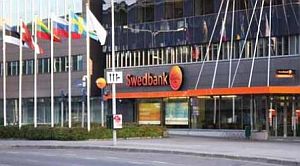Analytics, Baltic States – CIS, Economics, Estonia, GDP, Latvia, Port, Transport
International Internet Magazine. Baltic States news & analytics
Friday, 26.04.2024, 10:23
Swedbank cuts Latvia's and Estonia’s economic growth forecasts for 2014
 Print version
Print version |
|---|
At the beginning of the year, Swedbank said it expected Latvia's gross domestic product to increase 4.8% this year.
In 2015, Latvia's GDP could increase 3.5%, Strasuna said.
"The main reason for the slowing economic growth pace is the Russia-Ukraine conflict, as well as weak growth projections for Russia. We therefore expect exports to Russia to decrease. On the other hand, thanks to the global economic growth, export to Europe and other countries could increase, compensating for the fall in exports to Russia," said Strasuna.
Overall, Latvia's exports are likely to continue steady growth this year, albeit the growth will be slower than originally anticipated. Likewise, investment volumes are likely to decrease, hence the lowered GDP growth forecast.
"It has to be said though that the negative effect is rather concentrated. Several processing industry sectors and companies could suffer more than others, for instance, food and alcohol producers, as well as transport and transit flows. In the freight transport sector, Russia's long-term goal to switch freight flows to Russian ports, including to Ust-Luga, will have a negative effect on the transport sector. However, export growth will accelerate next year as growth in Europe and the world will become faster and the situation in Russia stabilize," explained Strasuna.
The increasing uncertainty may prompt businessmen put their investment plans on hold, which mostly concerns those exporting to Russia and C.I.S. countries, as well as slow down foreign investment in Latvia. In terms of investment, the start of the year looks quite promising, but a fall in investment volumes may occur in the latter part of the year, said Strasuna, adding that for the entire 2014, investment volume is expected to increase slightly, more so in 2015.
"Household consumption will remain the main driving force behind economic growth this year. Export and investments will also be growing, but not as fast," said Strasuna.
Swedbank has also lowered its original forecast of a 6% to 7% increase in wages this year, it currently expects wages to grow slightly more than 5% this year and about as much in 2015. Growth in productivity, however, is likely to be minimal this year.
The proportion of jobseekers will continue to steadily decrease, likely to fall below 10% already next year. Higher uncertainty and slower decrease in unemployment also mean slower increase in wages.
Swedbank also predicts inflation in Latvia to reach 1.5% this year and around 3.2% next year, added Strasuna. This is in part due to the government's decision to postpone deregulation of the electricity market for households.
Swedbank revealed on Tuesday that its economic growth forecast for Estonia for this year is 1.8% versus 3% growth it had forecast in January, Äripäev.ee/LETA reports.
Swedbank forecasts Estonia 3% economic growth for the year 2015; in January the bank forecast 3.7%.
Swedbank said on Tuesday that Estonia's inflation rate should fall this year to 1.3%. Three months ago it forecast 2.6%.
The bank expects the unemployment rate to be 8.4% this year versus 8.3% it had forecast in January.
Estonian Finance Ministry cut in its spring economic forecast revealed on Monday Estonia's economic growth forecast for this year to 2% and to 3.5% in 2015.
As reported, Latvia's GDP in 2013 increased 4.1% from 2012, according to the Central Statistical Bureau's data.








 «The Baltic Course» Is Sold and Stays in Business!
«The Baltic Course» Is Sold and Stays in Business!

